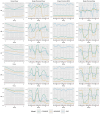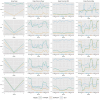Frequentist Grouped Weighted Quantile Sum Regression for Correlated Chemical Mixtures
- PMID: 40213957
- PMCID: PMC11987061
- DOI: 10.1002/sim.70078
Frequentist Grouped Weighted Quantile Sum Regression for Correlated Chemical Mixtures
Abstract
As individuals are exposed to a myriad of potentially harmful pollutants every day, it is important to determine which actors have the greatest influence on health outcomes. However, jointly modeling the associations of multiple pollutant exposures is often hindered by the presence of highly correlated chemicals originating from a common source. A popular approach to analyzing associations between a disease outcome and several highly correlated exposures is Weighted Quantile Sum Regression (WQSR) modeling. WQSR provides increased stability in estimating model parameters but requires data splitting to estimate individual and group effects of chemicals, which reduces the power of the approach. A recent Bayesian implementation of WQSR regression provides a model fitting procedure that avoids data splitting at the cost of high computational expense on large data. In this paper, we introduce a Frequentist Grouped Weighted Quantile Sum Regression (FGWQSR) model that can be fitted efficiently to large datasets without requiring data splitting. FGWQSR produces estimates of the joint effect of mixture groups and of individual chemicals, and likelihood-ratio-based tests that account for FGWQSR's non-standard asymptotics. We demonstrate that FGWQSR is well calibrated for type-I errors while outperforming both Bayesian Grouped Weighted Quantile Sum Regression and Quantile Logistic Regression in terms of statistical power to detect the effects of mixture groups and individual chemicals. In addition, we show that FGWQSR is robust to model misspecification and can be fitted on large datasets in a fraction of the time required for BGWQSR. We apply FGWQSR to a dataset of 317 767 mother-child pairs with exposure profiles generated by chemical transport models to study the associations between several components found in particulate matter with an aerodynamic diameter smaller than 2.5 (PM ) and child Autism Spectrum Disorder (ASD) diagnosis before age 5. PM copper and PM crustal material are found to be statistically significantly associated with ASD diagnosis by five years of age.
Keywords: autism spectrum disorder; chemical mixture modeling; constrained optimization; group sign constrained regression; non‐regular likelihood asymptotics; pollutant mixture modeling; weighted quantile sum regression.
Statistics in Medicine© 2025 The Author(s). Statistics in Medicine published by John Wiley & Sons Ltd.
Conflict of interest statement
The authors declare no conflicts of interest.
Figures




 component exposure generated from Source Oriented Chemical Transport models. Red points denote mean PM
component exposure generated from Source Oriented Chemical Transport models. Red points denote mean PM component exposure levels. Pollutant concentrations are displayed in units.
component exposure levels. Pollutant concentrations are displayed in units.
 components. Red boxes denote resulting clusters from hierarchical clustering on , where denotes the correlation matrix, using a complete linkage and a cutpoint value to establish 3 clusters.
components. Red boxes denote resulting clusters from hierarchical clustering on , where denotes the correlation matrix, using a complete linkage and a cutpoint value to establish 3 clusters.Similar articles
-
Part 1. Statistical Learning Methods for the Effects of Multiple Air Pollution Constituents.Res Rep Health Eff Inst. 2015 Jun;(183 Pt 1-2):5-50. Res Rep Health Eff Inst. 2015. PMID: 26333238
-
A Permutation Test-Based Approach to Strengthening Inference on the Effects of Environmental Mixtures: Comparison between Single-Index Analytic Methods.Environ Health Perspect. 2022 Aug;130(8):87010. doi: 10.1289/EHP10570. Epub 2022 Aug 30. Environ Health Perspect. 2022. PMID: 36040702 Free PMC article.
-
Bayesian Group Index Regression for Modeling Chemical Mixtures and Cancer Risk.Int J Environ Res Public Health. 2021 Mar 27;18(7):3486. doi: 10.3390/ijerph18073486. Int J Environ Res Public Health. 2021. PMID: 33801661 Free PMC article.
-
A review of common statistical methods for dealing with multiple pollutant mixtures and multiple exposures.Front Public Health. 2024 May 9;12:1377685. doi: 10.3389/fpubh.2024.1377685. eCollection 2024. Front Public Health. 2024. PMID: 38784575 Free PMC article. Review.
-
A review of practical statistical methods used in epidemiological studies to estimate the health effects of multi-pollutant mixture.Environ Pollut. 2022 Aug 1;306:119356. doi: 10.1016/j.envpol.2022.119356. Epub 2022 Apr 27. Environ Pollut. 2022. PMID: 35487468 Review.
References
-
- Colt J. S., Severson R. K., Lubin J., et al., “Organochlorines in Carpet Dust and Non‐Hodgkin Lymphoma,” Epidemiology 16, no. 4 (2005): 516–525. - PubMed
MeSH terms
Grants and funding
LinkOut - more resources
Full Text Sources
Research Materials
